Contrastive Object Detection Using Knowledge Graph Embeddings
Object recognition for the most part has been approached as a one-hot problem that treats classes to be discrete and unrelated. Each image region has to be assigned to one member of a set of objects, including a background class, disregarding any similarities in the object types. In this work, we compare the error statistics of the class embeddings learned from a one-hot approach with semantically structured embeddings from natural language processing or knowledge graphs that are widely applied in open world object detection. Extensive experimental results on multiple knowledge-embeddings as well as distance metrics indicate that knowledge-based class representations result in more semantically grounded misclassifications while performing on par compared to one-hot methods on the challenging COCO and Cityscapes object detection benchmarks. We generalize our findings to multiple object detection architectures by proposing a knowledge-embedded design for keypoint-based and transformer-based object detection architectures.
PDF Abstract




 MS COCO
MS COCO
 Cityscapes
Cityscapes
 ConceptNet
ConceptNet